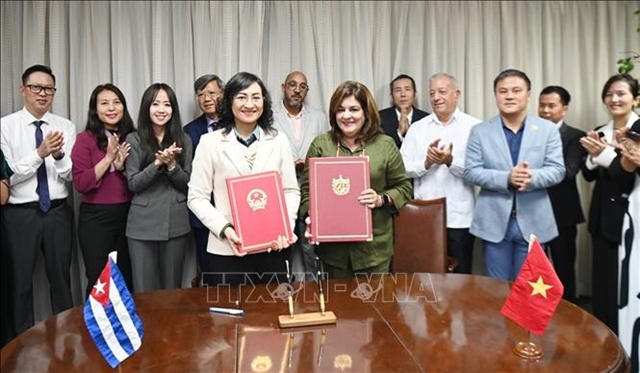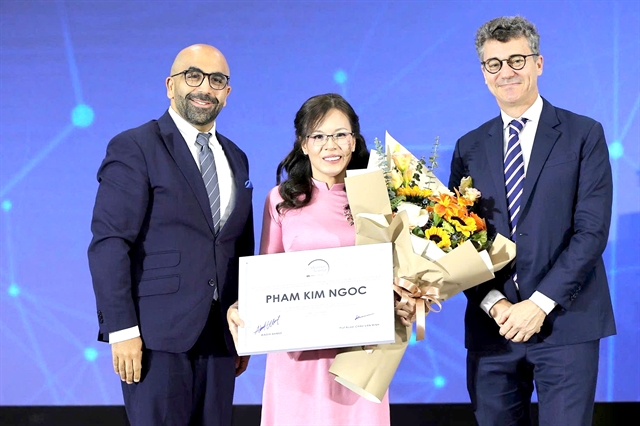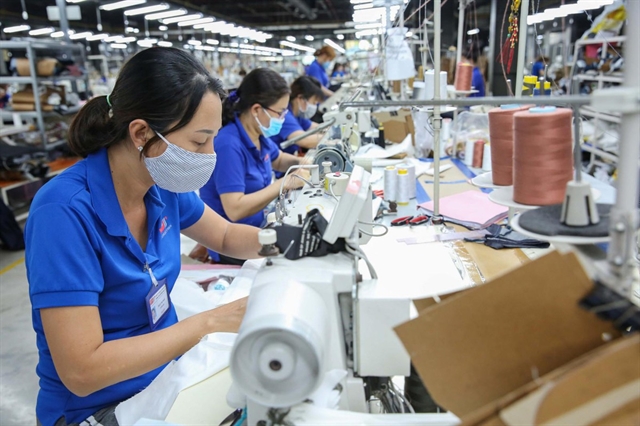 Economy
Economy


|
| Since the fourth quarter of 2022, textile and garment enterprises have had a shortage of export orders. Photo congthuong.vn |
HÀ NỘI — Textile and garment export value in the first quarter of 2023 reached US$7.1 billion, down 17 per cent compared to the same period in 2022, due to the impact of global inflation, according to the General Statistics Office (GSO).
This was the deepest decline in the first quarter since 2009, GSO said.
The global inflation made consumers tighten spending on non-essential products, causing textile and garment exports to major markets such as the US and EU to drop sharply.
There are many forecasts saying that the domestic textile and garment industry's exports growth will slump this year.
Since the fourth quarter of 2022, textile and garment enterprises have had a shortage of export orders, leading to a sharp drop in export turnover and factories operating at below capacity.
Export orders in the second and third quarters are still shrinking, and workers are working reduced hours.
Thân Đức Việt, general director of Garment 10 Corporation, said the reduced demand for textiles and garments this year was due to the impact of inflation, pandemic, and geopolitical tensions between Russia and Ukraine. In addition, concerns about financial market instability and a banking crisis have also affected demand.
In the first quarter of this year, exports of May 10 were estimated to decrease by 10 per cent compared to the same period last year.
Product volume in the second quarter is estimated to decrease by 20-30 per cent, and until now, May 10 has not received new orders for production in the third quarter, said Việt.
Việt Thắng Jean Co, Ltd (VitaJean), a large garment firm, has also reduced factory capacity, and temporarily closed a high-grade product production line because of a lack of orders.
Phạm Văn Việt, VitaJean chairman and vice chairman of the HCM City Garment, Embroidery and Knitting Association, said that purchasing power has not recovered in Japan, the US and EU, while it has reduced by about 20-30 per cent in February in the domestic market.
Phạm Văn Việt said that the prospects of the textile and garment industry in the first half of 2023 are still bleak. From the third quarter of 2023, the market may gradually recover, as the price of input materials decreases, reducing pressure on businesses.
However, all forecasts lack clarity because the conflict between Russia and Ukraine has not cooled down yet.
Coping with the downturn
In this context, textile and garment enterprises have to implement many solutions such as restructuring enterprises, markets and products to maintain production and keep workers while waiting for the market to warm up.
The VitaJean chairman said that besides traditional markets such as the US and EU, his company is trying to boost exports to Australia and Canada, and at the same time, increase domestic consumption to partly compensate for the decline in exports to the traditional markets.
Meanwhile, Thân Đức Việt said that May 10 has also restructured its businesses and sustainable development strategies. It also needs to review product position, market, management, technology, and production models to meet customer requirements.
He also said for the domestic market, this business is looking for products to meet the needs of customers in the context of the economic downturn.
For exports, May 10 is seeking new markets besides its traditional markets including the US, Europe and Japan.
Việt Nam's 15 signed free trade agreements (FTAs) bring a lot of opportunities to expand to new export markets, so South Africa, Africa, the Middle East and China are likely to all be huge markets in the future, he said.
The May 10 general director said now is also the time of sustainable development associated with green production.
The world is encouraging green growth, and Việt Nam committed to reduce carbon emissions at COP26. Therefore, May 10 is switching to using green materials and green energy. As it increases the proportion of green products, this business will have many opportunities to promote production and exports in the future.
Vũ Đức Giang, Chairman of the Vietnam Textile and Apparel Association (Vitas), said that the textile and garment industry last year still exported product worth more than $42.2 billion, up 8.5 per cent over the same period the previous year.
However, that result mainly came from export growth in the first six months of the year. From the third quarter of 2022, exports began to show signs of weakness due to China's zero-COVID policy and the global recession.
The textile and garment industry's production continued to deteriorate in late 2022 and remained in that situation until the first quarter of 2023.
In 2023, Giang forecasts that the textile and garment business will still have many challenges. The most significant is the trend of increased layoffs and moving the workforce away from big cities.
Meanwhile, domestic enterprises have not been able to meet a number of complex orders.
Foreign markets also have requirements for recycled products and transparency in operations. Those are issues that businesses cannot immediately respond to, especially small and medium sized enterprises.
According to Giang, the most important solution now is to diversify markets, products and brands produced in Việt Nam.
On the other hand, businesses should use more green and recycled products, and have infrastructure investment plans and in-depth strategies to meet the requirements of foreign markets.
In addition, textile and garment enterprises need strategies to respond to the fast changes of the market, such as fast delivery times, competitive prices, stable quality, and transparency in products.
Businesses also need to build connection channels to grasp the challenges and opportunities of the global textile industry, digital technology trends and new policies.
Giang said that large-scale enterprises with production chains of yarn, weaving, dyeing and sewing, will survive, while businesses specialising in processing will face great challenges. — VNS


.jpg)
.jpg)
.jpg)